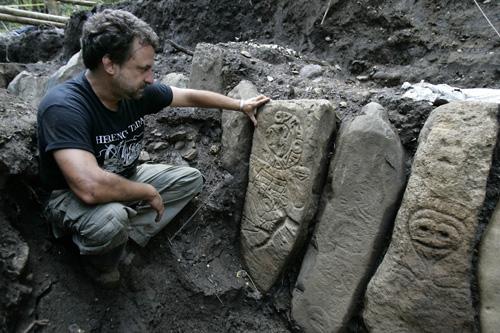Well-preserved pre-Columbian site discovered in Puerto Rico

Puerto Rican archaeologist Hernan Bustelo sits next stones etched with ancient petroglyphs and graves that reveal unusual burial methods in Ponce, Puerto Rico, on Tuesday. Laura Prusik
Oct 29, 2007
Last updated on May 12, 2016 at 05:55 p.m.
SAN JUAN, Puerto Rico – U.S. and Puerto Rican archaeologists say they have found the best-preserved pre-Columbian site in the Caribbean, which could shed light on virtually every aspect of Indian life in the region, from sacred rituals to eating habits.
The archaeologists believe the site in southern Puerto Rico may have belonged to the Taino or pre-Taino people that inhabited the island before European colonization, although other tribes are a possibility. It contains stones etched with ancient petroglyphs that form a large plaza measuring some 130 feet by 160 feet, which could have been used for ball games or ceremonial rites, said Aida Belen Rivera, director of the Puerto Rican Historic Conservation office.
The petroglyphs include the carving of a human figure with masculine features and frog legs.
Archaeologists also uncovered several graves with bodies buried face-down with the legs bent at the knees – a style never seen before in the region.
Get The Daily Illini in your inbox!
The plaza may contain other artifacts dating from 600 A.D. to 1500 A.D., including piles of refuse from daily life, Rivera said.
“I have visited many sites and have never seen a plaza of that magnitude and of those dimensions and with such elaborate petroglyphs,” said Miguel Rodriguez, member of the government’s archaeological council and director of a graduate school in Puerto Rico that specializes in history and humanities. He is not involved in the excavation project.
Archeologists have known since 1985 that the area contained indigenous artifacts. But their extent and significance only became clear this month when the U.S. Army Corps of Engineers began work on removing them so the land could be used for a dam project.
Experts called for a halt to the excavation, saying the use of heavy machinery exposed the stones to the elements and may have destroyed important artifacts. The Corps of Engineers has said the site will be preserved.
The Tainos were a subgroup of the Arawak Indians, who migrated to the Caribbean from Mexico’s Yucatan centuries before European colonizers arrived.
Jose Oliver, a Latin American archaeology lecturer at University College London, said that archeologists make discoveries of this significance every 50 or 100 years – if they are lucky.
“I’m convinced that a competent investigation of that site will offer us a rare perspective on our pre-Columbian and pre-colonial history,” Oliver, who has overseen several high-profile digs in Puerto Rico, said by e-mail.





